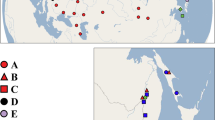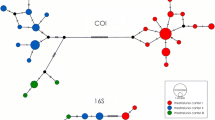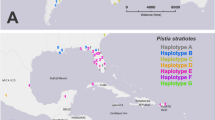Abstract
The freshwater isopod Paramphisopus palustris is ubiquitous and abundant in the groundwater-fed wetlands of the Swan Coastal Plain around Perth, Western Australia. Taxonomically, an additional variety (P. palustris fairbridgei) and species (P. montanus) are recognized from geographically outlying localities. Here a 486 bp fragment of cytochrome c oxidase subunit I (COI) mtDNA was sequenced in 68 individuals from 23 localities in order to evaluate the accepted taxonomy, to examine the evolutionary history of the species, and to identify lineages to prioritize conservation of wetlands already substantially modified. MtDNA showed individual populations to be largely distinct and differentiated. The 41 unique haplotypes formed seven independent, geographically defined networks. Phylogenetic analysis retrieved corresponding subclades, with three well-supported larger clades occurring (1) north of the Swan River, (2) south of the Swan River, and (3) in an area further south. A clear pattern of isolation by distance was detected suggesting an ancient serial founder event, with the pattern possibly persisting in the face of limited gene flow through priority effects. The possibility of incipient speciation, the monophyly of the recognized subspecies and the paraphyly of P. palustris with respect to P. montanus, suggest that the current taxonomy is invalid and requires re-examination. Divergences suggest a mid- to early Pliocene divergence of the major clades, with early Pliocene divergences among subclades probably driven by documented intense arid periods. Lineages are present in wetlands in geologically younger environments suggesting in situ survival and persistence. Seven Evolutionarily Significant Units were identified for the conservation of Paramphisopus, two of which are not currently represented in conservation reserves. With increased water demand and the negative impact of surrounding land-use, the current study provides a first phylogeographic assessment of conservation priorities for wetlands of the Swan Coastal Plain.



Similar content being viewed by others
References
Akaike, H., 1974. A new look at the statistical model identification. Institute of Electrical and Electronics Engineers Transactions on Automatic Control 19: 716–723.
Arnold, J. M., 1990. Perth Wetlands Resource Book (Bulletin 266). Environmental Protection Authority and the Water Authority of Western Australia, Perth.
Balla, S. A. & J. A. Davis, 1993. Wetlands of the Swan Coastal Plain, Vol. 5. Managing Perth’s wetlands to conserve the aquatic fauna. Water Authority of Western Australia, Leederville, Perth.
Bastian, L. V., 1996. Residual soil mineralogy and dune subdivision, Swan Coastal Plain, Western Australia. Australian Journal of Earth Sciences 43: 31–44.
Cavalcanti, M. J., 2005. MANTEL for Windows. Test for association between two symmetrical distance matrices with permutation iterations. Version 1.18. Departemento de Vertebrados, Museu Nacional do Rio de Janiero, Brazil.
Cheal, F., J. A. Davis & J. E. Growns, 1993. Relationships between macroinvertebates and environmental variables. In Davis, J. A., R. S. Rosich, J. S. Bradley, J. E. Growns, L. G. Schmidt & F. Cheal (eds), Wetlands of the Swan Coastal Plain, Vol. 6. Wetland classification on the basis of water quality and invertebrate community data. Water Authority of Western Australia, Leederville, Perth, 16–18.
Chessman, B. C., K. M. Trayler & J. A. Davis, 2002. Family- and species-level biotic indices for macroinvertebrates of wetlands on the Swan Coastal Plain, Western Australia. Marine and Freshwater Research 53: 919–930.
Churchill, D. M., 1959. Late Quaternary eustatic changes in the Swan River district. Journal of the Royal Society of Western Australia 41: 53–55.
Clarke, J. D. A., 1994. Evolution of the Lefroy and Cowan Palaeodrainage channels, Western Australia. Australian Journal of Earth Sciences 41: 55–68.
Clement, M., D. Posada & K. A. Crandall, 2000. TCS: a computer program to estimate gene genealogies. Molecular Ecology 9: 1657–1660.
Davis, J. A., J. S. Bradley & J. E. Growns, 1993. General introduction. In Davis, J. A., R. S. Rosich, J. S. Bradley, J. E. Growns, L. G. Schmidt & F. Cheal (eds), Wetlands of the Swan Coastal Plain, Vol. 6. Wetland classification on the basis of water quality and invertebrate community data. Water Authority of Western Australia, Leederville, Perth, 16–18.
Davis, J. A. & R. S. Rosich, 1993a. Conclusions and implications for management. In Davis, J. A., R. S. Rosich, J. S. Bradley, J. E. Growns, L. G. Schmidt & F. Cheal (eds), Wetlands of the Swan Coastal Plain, Vol. 6. Wetland classification on the basis of water quality and invertebrate community data. Water Authority of Western Australia, Leederville, Perth, 221–230.
Davis, J. A. & R. S. Rosich, 1993b. Executive summary. In Davis, J. A., R. S. Rosich, J. S. Bradley, J. E. Growns, L. G. Schmidt & F. Cheal (eds), Wetlands of the Swan Coastal Plain, Vol. 6. Wetland classification on the basis of water quality and invertebrate community data. Water Authority of Western Australia, Leederville, Perth, 7–15.
De Gelas, K. & de Meester L., 2005. Phylogeography of Daphnia magna in Europe. Molecular Ecology 14: 753–764.
De Meester, L., A. Gómez, B. Okamura & K. Schwenk, 2002. The Monopolization Hypothesis and the dispersal-gene flow paradox in aquatic organisms. Acta Oecologia 23: 121–135.
Dodson, J. R. & M. K. Macphail, 2004. Palynological evidence for aridity events and vegetation changes during the Middle Pliocene, a warm period in Southwestern Australia. Global and Planetary Change 41: 285–307.
Excoffier, L., G. Laval & S. Schneider, 2005. Arlequin ver. 3.0: an integrated software package for population genetics data analysis. Evolutionary Bioinformatics Online 1: 47–50.
Felsenstein, J., 1985. Confidence limits on phylogenies: an approach using the bootstrap. Evolution 39: 783–791.
Excoffier, L., P. Smouse & J. Quattro, 1992. Analysis of molecular variance inferred from metric distances among DNA haplotypes: application to human mitochondrial DNA restriction data. Genetics 131: 479–491.
Folmer, O., M. Black, W. Hoeh, R. Lutz & R. Vrijenhoek, 1994. DNA primers for amplification of mitochondrial cytochrome c oxidase subunit I from diverse metazoan invertebrates. Molecular Marine Biology and Biotechnology 3: 294–299.
Glauert, L., 1924. Contributions to the fauna of Western Australia, no. 4. A freshwater isopod Phreatoicus palustris. n. sp. Journal of the Royal Society of Western Australia 10: 49–57.
Gómez, A., G. J. Adcock, D. H. Lunt & G. R. Carvalho, 2002. The interplay between colonization history and gene flow in passively dispersing zooplankton: microsatellite analysis of rotifer resting egg banks. Journal of Evolutionary Biology 15: 158–171.
Gouws, G., B. A. Stewart & S. R. Daniels, 2006. Phylogeographic structure of a freshwater crayfish (Decapoda: Parastacidae: Cherax preissii) in south-western Australia. Marine and Freshwater Research 57: 837–848.
Gouws, G., B. A. Stewart & C. A. Matthee, 2005. Lack of taxonomic differentiation in an apparently widespread freshwater isopod morphotype (Phreatoicidea: Mesamphisopidae: Mesamphisopus) from South Africa. Molecular Phylogenetics and Evolution 37: 289–305.
Growns, J. E., J. A. Davis, F. Cheal & J. S. Bradley, 1993a. Classification of the wetlands using invertebrate data. In Davis, J. A., R. S. Rosich, J. S. Bradley, J. E. Growns, L. G. Schmidt & F. Cheal (eds), Wetlands of the Swan Coastal Plain, Vol. 6. Wetland classification on the basis of water quality and invertebrate community data. Water Authority of Western Australia, Leederville, Perth, 88–156.
Growns, J. E., L. G. Schmidt & F. Cheal, 1993b. Site descriptions and general methods. In Davis, J. A., R. S. Rosich, J. S. Bradley, J. E. Growns, L. G. Schmidt & F. Cheal (eds), Wetlands of the Swan Coastal Plain, Vol. 6. Wetland classification on the basis of water quality and invertebrate community data. Water Authority of Western Australia, Leederville, Perth, 19–28.
Hasegawa, M., K. Kishino & T. Yano, 1985. Dating the human-ape splitting by a molecular clock of mitochondrial DNA. Journal of Molecular Evolution 22: 160–174.
Hopper, S. D. & P. Gioia, 2004. The Southwest Australian Floristic Region: evolution and conservation of a global hot spot of biodiversity. Annual Review of Ecology, Evolution and Systematics 35: 623–650.
Jarman, S. N., 2004. Amplicon: software for designing PCR primers on aligned DNA sequences. Bioinformatics 20: 1644–1645.
Keable, S. J. & G. D. F. Wilson, 2006. New species of Pygolabis Wilson, 2003 (Isopoda, Tainisopidae, Crustacea) from Western Australia. Zootaxa 1116: 1–27.
Ketmaier, V., R. Argano & A. Caccone, 2003. Phylogeography and molecular rates of subterranean aquatic stenasellid isopods with a peri-Tyrrhenian distribution. Molecular Ecology 12: 547–555.
Kimura, M., 1981. Estimation of evolutionary distances between homologous nucleotide sequences. Proceedings of the National Academy of Sciences of the United States of America 78: 454–458.
Knott, B. & S. A. Halse, 1999. Pilbarophreatoicus platyarthricus n.gen., n.sp. (Isopoda: Phreatoicidea: Amphisopididae) from the Pilbara region of Western Australia. Records of the Australian Museum 51: 33–42.
Majer, K., 1979a. Wetlands of the Darling System: wetland reserves and their management. Bulletin No. 62. Department of Conservation and Environment, Lesmurdie, Western Australia.
Majer, K., 1979b. Wetlands of the Darling System: wetlands in conservation reserves and national parks. Bulletin No. 61. Department of Conservation and Environment, Lesmurdie, Western Australia.
Mantel, N., 1967. The detection of disease clustering and a generalized regression approach. Cancer Research 27:209–220.
McGaughran, A., I. D. Hogg, M. I. Stevens, W. L. Chadderton & M. J. Winterbourn, 2006. Genetic divergence of three freshwater isopod species from southern New Zealand. Journal of Biogeography 33: 23–30.
Mitchell, D., K. Williams & A. Desmond, 2003. Swan Coastal Plain 2 (SWA2—Swan Coastal Plain subregion). In May, J. A. & N. L. McKenzie (eds), A Biodiversity Audit of Western Australia’s 53 Biogeographical Subregions in 2002. Department of Conservation and Land Management, Kensington, Perth, 606–623.
Moritz, C., 1995. Uses of molecular phylogenies for conservation. Philosophical Transactions of the Royal Society of London B 349: 113–118.
Moritz, C., 1999. Conservation units and translocations: strategies for conserving evolutionary processes. Hereditas 130: 217–228.
Nicholls, G. E., 1924. Phreatoicus lintoni, a new species of freshwater isopod from south-western Australia. Journal of the Royal Society of Western Australia 10: 92–103.
Nicholls, G. E., 1926. A description of two new genera and species of Phreatoicidea, with a discussion of the affinities of the members of this family. Journal of the Royal Society of Western Australia 12: 179–210.
Nicholls, G. E., 1943. The Phreatoicoidea. Part I. The Amphisopidae. Papers and Proceedings of the Royal Society of Tasmania 1942: 1–145.
Nicholls, G. E. & D. F. Milner, 1923. A new genus of fresh-water Isopoda, allied to Phreatoicus. Journal of the Royal Society of Western Australia 10: 23–34.
Posada, D., 2004. Collapse: describing haplotypes from sequence alignments. Version 1.2. (http://darwin.uvigo.es).
Posada, D. & K. A. Crandall, 1998. MODELTEST: testing the model of DNA substitution. Bioinformatics 14: 817–818.
Ramachandran, S., O. Deshpande, C. C. Roseman, N. A. Rosenberg, M. W. Feldman & L. L. Cavalli-Sforza, 2005. Support from the relationship of genetic and geographic distance in human populations for a serial founder effect originating in Africa. Proceedings of the National Academy of Sciences of the United States of America 102: 15942–15947.
Rivera, M. A. J., F. G. Howart, S. Taiti & G. K. Roderick, 2002. Evolution in Hawaiian cave-adapted isopods (Oniscidea: Philosciidae): vicariant speciation or adaptive shifts? Molecular Phylogenetics and Evolution 25: 1–9.
Schmidt, L. G., J. E. Growns & F. Cheal, 1993. Other factors of environmental significance. In Davis, J. A., R. S. Rosich, J. S. Bradley, J. E. Growns, L. G. Schmidt & F. Cheal (eds), Wetlands of the Swan Coastal Plain, Vol. 6. Wetland classification on the basis of water quality and invertebrate community data. Water Authority of Western Australia, Leederville, Perth, 214–220.
Schmidt, L. G. & R. S. Rosich, 1993. Phytoplankton community structure in relation to physical and chemical gradients. In Davis, J. A., R. S. Rosich, J. S. Bradley, J. E. Growns, L. G. Schmidt & F. Cheal (eds), Wetlands of the Swan Coastal Plain, Vol. 6. Wetland classification on the basis of water quality and invertebrate community data. Water Authority of Western Australia, Leederville, Perth, 157–170.
Semeniuk, V., 1997. Pleistocene coastal palaeogeography in southwestern Australia—carbonate and quartz sand sedimentation in cuspate forelands, barriers and ribbon shoreline deposits. Journal of Coastal Research 13: 468–489.
Sheppard, E. M., 1927. Revision of the family Phreatoicidae (Crustacea), with a description of two new species. Proceedings of the Zoological Society of London 1927: 81–124.
Swofford, D. L., 2002. PAUP*. Phylogenetic Analysis Using Parsimony (*and Other Methods). Version 4. Sinauer Associates Inc., Sunderland, Massachusetts.
Tamura, K., 1992. Estimation of the number of nucleotide substitutions when there are strong transition-transversion and G + C content biases. Molecular Biology and Evolution 9: 678–687.
Templeton, A. R., E. Routman & C. A. Phillips, 1995. Separating population structure from population history: a cladistic analysis of the geographical distribution of mitochondrial DNA haplotypes in the tiger salamander, Ambystoma tigrinum. Genetics 140: 767–782.
Unmack, P. J., 2001. Biogeography of Australian freshwater fishes. Journal of Biogeography 28: 1053–1089.
Verovnik, R., B. Sket & P. Trontelj, 2004. Phylogeography of subterranean and surface populations of water lice Asellus aquaticus (Crustacea: Isopoda). Molecular Ecology 13: 1519–1532.
Walsh, P. S., D. A. Metzger & R. Higuchi, 1991. Chelex 100 as a medium for simple extraction of DNA for PCR-based typing from forensic material. BioTechniques 10: 506–513.
Wang, M. & A. Schreiber, 1999a. Population differentiation in the woodlouse Oniscus asellus in central Europe (Isopoda: Oniscoidea). Journal of Crustacean Biology 19: 301–312.
Wang, M. & A. Schreiber, 1999b. Population genetics of the woodlouse Porcellio scaber Latr. (Isopoda: Oniscoidea) in central Europe: passive dispersal and postglacial range expansion. Canadian Journal of Zoology 77: 1337–1347.
Wilson, G. D. F. & G. D. Edgecombe, 2003. The Triassic isopod Protamphisopus wianamattensis (Chilton) and comparison with extant taxa (Crustacea, Phreatoicidea). Journal of Paleontology 77: 454–470.
Wilson, G. D. F. & E. L. Ho, 1996. Crenoicus Nicholls, 1944 (Crustacea, Isopoda, Phreatoicidea): systematics and biology of a new species from New South Wales. Records of the Australian Museum 48: 7–32.
Wilson, G. D. F. & S. J. Keable, 1999. A new genus of phreatoicidean isopod (Crustacea) from the north Kimberley region, Western Australia. Zoological Journal of the Linnean Society 126: 51–79.
Wilson, G. D. F. & S. J. Keable, 2002. New genera of Phreatoicidea (Crustacea: Isopoda) from Western Australia. Records of the Australian Museum 54: 41–70.
Wright, S., 1943. Isolation by distance. Genetics 28: 114–138.
Acknowledgements
This study was funded by Australian Biological Resources Study (ABRS) Participatory Program Grants (203-032 and 204-010), provided by the Department of the Environment and Heritage. The senior author was supported by a South African National Research Foundation Postdoctoral Scholarship for Research Abroad (GUN 2062031) and hosted by both the School of Animal Biology and the Centre of Excellence in Natural Resource Management, The University of Western Australia. The authors thank Dennis and Leisha Davis, Rebecca Dobbs, Geraldine Janicke, Anna Price and Ben Puglisi for providing assistance in the field, laboratory or in the preparation of the manuscript. The authors are grateful for the comments, discussion and suggestions provided by the population genetics group of the School of Animal Biology. We thank the editor and two anonymous reviewers whose comments vastly improved the manuscript.
Author information
Authors and Affiliations
Corresponding author
Additional information
Handling editor: C. Sturmbauer
Electronic supplementary material
Below are the electronic supplementary materials.
Rights and permissions
About this article
Cite this article
Gouws, G., Stewart, B.A. From genetic structure to wetland conservation: a freshwater isopod Paramphisopus palustris (Phreatoicidea: Amphisopidae) from the Swan Coastal Plain, Western Australia. Hydrobiologia 589, 249–263 (2007). https://doi.org/10.1007/s10750-007-0742-2
Received:
Revised:
Accepted:
Published:
Issue Date:
DOI: https://doi.org/10.1007/s10750-007-0742-2




